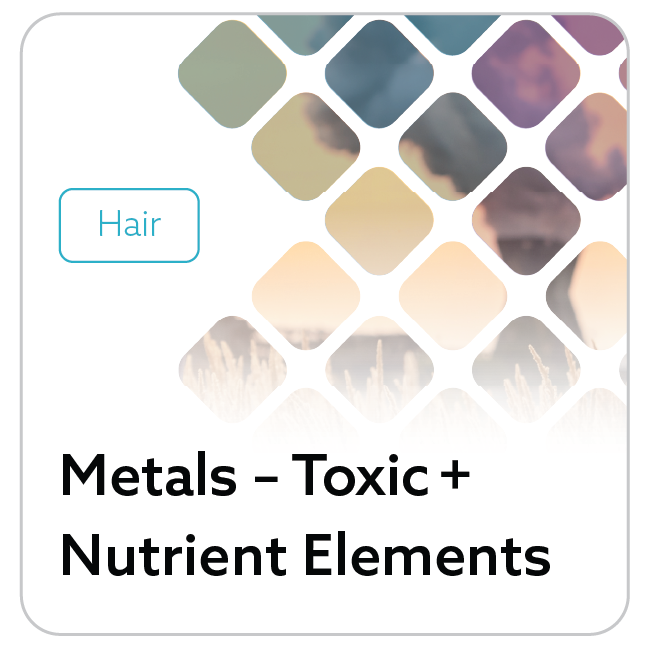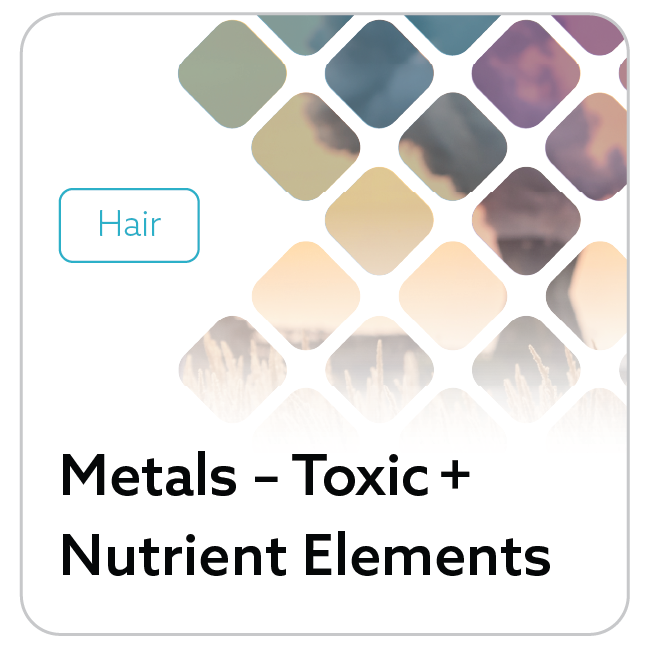MosaicDX offers a number of options for assessing nutrient and toxic (heavy metals) elements, these include urine, hair, stool, whole blood and red blood cell. Heavy metals can be toxic to organ systems when they accumulate in the body and may disrupt the balance of essential nutrients. A number of variables impact which sample type is most applicable including toxicokinetics, dose, length of exposure, route of exposure and half-life. Multiple sample types allow for the practitioner to choose the most clinically appropriate option.
Metals – Toxic + Nutrient Elements – Hair
Metals – Toxic + Nutrient Elements – Hair
Regular price
$185.00 USD
Regular price
Sale price
$185.00 USD
Unit price
per
Shipping calculated at checkout.
Couldn't load pickup availability
Essential Nutrient and Toxic Elements Testing
What patients might benefit from Heavy Metals Testing?
Sign and symptoms vary for each type of metal and range in severity based on an individual’s exposure, symptoms could include:
- Weakness
- Nausea or vomiting
- GI upset, diarrhea
- Dehydration
- Numbness or prickly sensation in hands and feet
- Chills, low body temperature
- Arrhythmia
- Anemia
- Memory loss
- Difficulty breathing
- Organ damage, kidney, liver
- Risk of developing certain types of cancer
Details
Heavy metals can accumulate within the body after exposure, attaching to your cells preventing them from performing their functions, causing symptoms that could be life threatening without treatment
Several metals can be toxic to the body. The most common toxic metals and where they can be found are:
Lead
Contaminated water from lead pipes, batteries, paint, gasoline, construction materials.
Mercury
Liquid in thermometers, lightbulbs, dental amalgam (“silver”) fillings, batteries, seafood, topical antiseptics.
Arsenic
Topical creams, herbicides, insecticides, pesticides, fungicides, paints, enamels, glass, contaminated water, seafood, algae.
Cadmium
Cigarette smoke, metal plating, batteries.
Thallium
Rodenticides, pesticides, fireworks.
Analytes
| Hair | |
|---|---|
| Toxic + Nutrient Elements |
|
| Analyte Count | 39 |
| Aluminium | ✓ |
| Antimony | ✓ |
| Arsenic | ✓ |
| Barium | ✓ |
| Beryllium | ✓ |
| Bismuth | ✓ |
| Boron | ✓ |
| Cadmium | ✓ |
| Calcium | ✓ |
| Cesium | |
| Chromium | ✓ |
| Cobalt | ✓ |
| Copper | ✓ |
| Gadolinium | |
| Germanium | ✓ |
| Iodine/Iodide | ✓ |
| Iron | ✓ |
| Lead | ✓ |
| Lithium | ✓ |
| Magnesium | ✓ |
| Mangagese | ✓ |
| Mercury | ✓ |
| Molybdenum | ✓ |
| Nickel | ✓ |
| Palladium | |
| Phosphorus | ✓ |
| Platinum | ✓ |
| Potassium | ✓ |
| Rubidium | ✓ |
| Selenium | ✓ |
| Silver | ✓ |
| Sodium | ✓ |
| Strontium | ✓ |
| Sulfur | ✓ |
| Tellurium | |
| Thallium | ✓ |
| Thorium | ✓ |
| Tin | ✓ |
| Titanium | ✓ |
| Tungsten | |
| Uranium | ✓ |
| Vanadium | ✓ |
| Zinc | ✓ |
| Zirconium | ✓ |
| Ratio: Calcium/Magnesium |
✓ |
| Ratio: Sodium/Potassium |
✓ |
| Ratio: Zinc/Copper |
✓ |
| Ratio: Zinc/Cadmium |
✓ |
| Ratio: Calcium/Phosphorus |
✓ |
Specimen Requirement
Hair
Please see collection instructions for detailed instructions.






